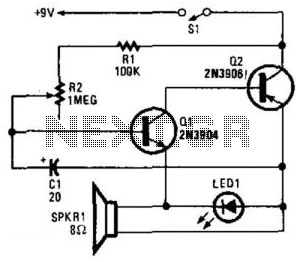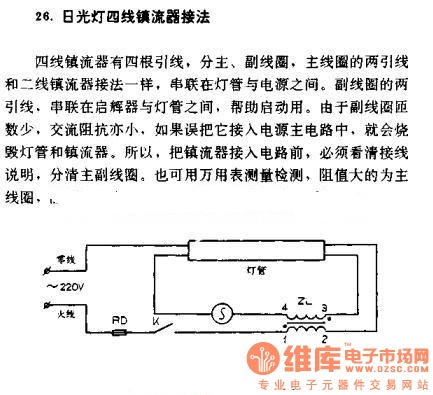
LM3915 audio power level meter circuit design electronic project

The LM3915 monolithic integrated circuit can be used to design a simple audio power level meter that senses analog voltage levels and drives ten LEDs, LCDs, or vacuum fluorescent displays, providing a logarithmic 3 dB/step analog display. One pin of the LM3915 changes the display from a bar graph to a moving dot display. The LED current drive is regulated and programmable, eliminating the need for current limiting resistors. Replacing conventional meters with an LED bar graph results in a faster responding, more rugged display with high visibility that retains the ease of interpretation of an analog display. LED brightness is easily controlled with a single potentiometer.
The LM3915 is a versatile integrated circuit specifically designed for audio power level metering applications. This device can accurately sense analog voltage levels, translating these signals into visual representations via ten output channels that can drive various display types, including LEDs, LCDs, or vacuum fluorescent displays. The logarithmic scaling of the output allows for a 3 dB per step indication, which is particularly useful in audio applications where power levels can vary significantly.
The functionality of the LM3915 includes the ability to configure the display mode through a specific pin. This feature allows the user to switch between a bar graph representation and a moving dot display, providing flexibility in the visual output according to user preference or application requirements. The choice between these two modes can enhance the interpretability of the audio levels being monitored.
One of the key advantages of utilizing the LM3915 is its regulated and programmable LED current drive. This feature eliminates the need for external current limiting resistors, simplifying the circuit design and enhancing reliability. The absence of resistors reduces the component count and potential points of failure, making the overall system more robust.
The transition from traditional analog meters to an LED bar graph display offers several benefits. The LED display is not only faster in response time but also more durable and visible under various lighting conditions. This increased visibility aids in the quick interpretation of audio levels, which is critical in live sound environments or monitoring applications.
Furthermore, the brightness of the LEDs can be easily adjusted using a single potentiometer, allowing for customization based on the ambient lighting conditions or user preferences. This adjustability ensures that the display remains effective and comfortable to view over extended periods, enhancing the user experience in practical applications. Overall, the LM3915 integrated circuit provides a powerful and efficient solution for audio power level metering with modern display technologies.using the LM3915 monolithic integrated circuit can be designed a very simple audio power level meter that senses analog voltage levels and drives ten LEDs, LCDs or vacuum fluorescent displays, providing a logarithmic 3 dB/step analog display. One pin of the LM39145 changes the display from a bar graph to a moving dot display. LED current drive is regulated and programmable, eliminating the need for current limiting resistors. Replacing conventional meters with an LED bar graph results in a faster responding, more rugged display with high visibility that retains the ease of interpretation of an analog display. LED brightness is easily controlled with a single pot. 🔗 External reference
The LM3915 is a versatile integrated circuit specifically designed for audio power level metering applications. This device can accurately sense analog voltage levels, translating these signals into visual representations via ten output channels that can drive various display types, including LEDs, LCDs, or vacuum fluorescent displays. The logarithmic scaling of the output allows for a 3 dB per step indication, which is particularly useful in audio applications where power levels can vary significantly.
The functionality of the LM3915 includes the ability to configure the display mode through a specific pin. This feature allows the user to switch between a bar graph representation and a moving dot display, providing flexibility in the visual output according to user preference or application requirements. The choice between these two modes can enhance the interpretability of the audio levels being monitored.
One of the key advantages of utilizing the LM3915 is its regulated and programmable LED current drive. This feature eliminates the need for external current limiting resistors, simplifying the circuit design and enhancing reliability. The absence of resistors reduces the component count and potential points of failure, making the overall system more robust.
The transition from traditional analog meters to an LED bar graph display offers several benefits. The LED display is not only faster in response time but also more durable and visible under various lighting conditions. This increased visibility aids in the quick interpretation of audio levels, which is critical in live sound environments or monitoring applications.
Furthermore, the brightness of the LEDs can be easily adjusted using a single potentiometer, allowing for customization based on the ambient lighting conditions or user preferences. This adjustability ensures that the display remains effective and comfortable to view over extended periods, enhancing the user experience in practical applications. Overall, the LM3915 integrated circuit provides a powerful and efficient solution for audio power level metering with modern display technologies.using the LM3915 monolithic integrated circuit can be designed a very simple audio power level meter that senses analog voltage levels and drives ten LEDs, LCDs or vacuum fluorescent displays, providing a logarithmic 3 dB/step analog display. One pin of the LM39145 changes the display from a bar graph to a moving dot display. LED current drive is regulated and programmable, eliminating the need for current limiting resistors. Replacing conventional meters with an LED bar graph results in a faster responding, more rugged display with high visibility that retains the ease of interpretation of an analog display. LED brightness is easily controlled with a single pot. 🔗 External reference
Warning: include(partials/cookie-banner.php): Failed to open stream: Permission denied in /var/www/html/nextgr/view-circuit.php on line 713
Warning: include(): Failed opening 'partials/cookie-banner.php' for inclusion (include_path='.:/usr/share/php') in /var/www/html/nextgr/view-circuit.php on line 713





